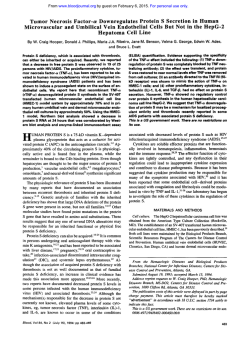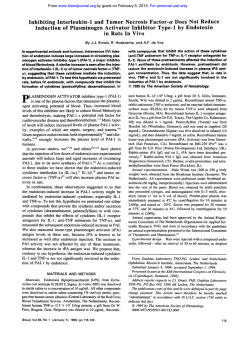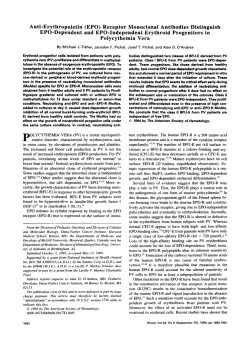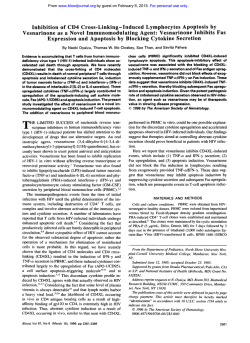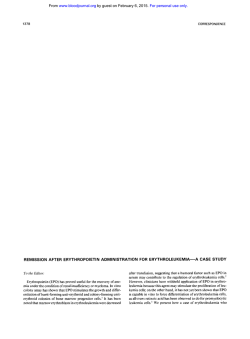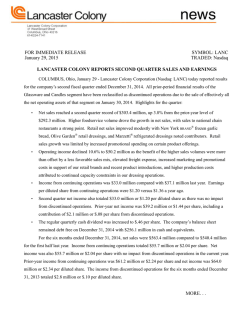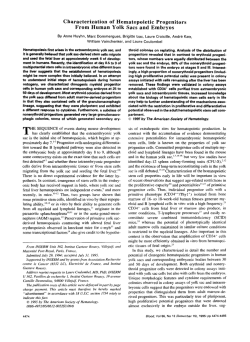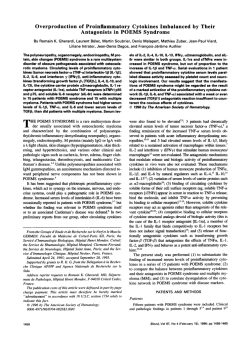
Tumor Necrosis Factor (TNF)-a Directly Inhibits
From www.bloodjournal.org by guest on February 6, 2015. For personal use only. Tumor Necrosis Factor (TNF)-a Directly Inhibits Human Erythropoiesis In Vitro: Role of p55 and p75 TNF Receptors By Leiv S. Rusten and Sten Eirik W. Jacobsen is mainly mediated through TNFR-p55, although TNFR-p75Two tumor necrosis factor receptors (TNFRs) with molecular mediated inhibition could be observed on progenitors reweights of55kD(TNFR-p55)and75kD(TNFR-p75)have sponsive to erythropoietin alone. Moreover, at low TNF-a recentlybeenidentifiedandcloned.Inpreviousstudies, concentrations (2 ng/mL), TNF-a stimulates interleukin-3TNFR-p55 has been shown to exclusively mediate bidirectional effects of TNF-a on committed bone marrow granulo- dependent in vitro growth of committed granulocyte-macrophage progenitor cells, whereas it potently inhibits erycyte-macrophage progenitorcells, whereas both TNFR-p55 throid progenitor cell proliferation, showing that one conand TNFR-p75 can mediate inhibition of primitive progenicentration of TNF-a can simultaneously and bidirectionally tors requiring multiple cytokines to proliferate. We show modulateinterleukin-3-dependentgrowth of committed here that TNF-a potently and directly inhibits the in vitro granulocyte-macrophage(stimulation)anderythroidprogrowth of committed erythroid progenitor cells in response genitor cells (inhibition). to multiple cytokine combinations, and that TNF-a-induced 0 7 9 9 5 by The American Societyof Hematology. inhibition of burst-forming unit-erythroid colony formation Furthermore, because TNF-a has been implicated in the UMOR NECROSIS FACTOR-a (TNF-a),a multifuncpathogenesis of the anemia associated with chronic distional cytokine shown to affect a number of different it is important to determine which of the two TNFRs cell types,I4 is mainly produced by activated macrophages mediates this effect. and lymphocyte^.^.^ In hematopoiesis, TNF-a acts as both a Whereas TNF-a has been shown to have potent antitumor positive and negative regulator of myeloid cell proliferation activity,' its clinical use has been hampered by severe toxic and differentiation."" The effects of TNF-a can be mediated side effect^.“^ The recent development of TNF-a mutants either directly'2,'6 or indirectly by inducing other cells to with selective activity on either TNFR-p55 or TNFR-p75 has produce hematopoietic growth factor^.'^.'^ Furthermore, opened the potentiality of reducing the serious side effects of TNF-a can modulate the expression of c-ki?' as well as cell TNF-a while maintaining the anticancer effect.M4a surface receptors for the colony-stimulating factors (CSFs) The present study was designed to determine the direct on both normal bone marrow (BM) cells and acute myeloid effects of TNF-a on erythroid colony formation in response leukemia cells.'632'-26 to growth factor combinations not previously explored for Several previous studies have demonstrated inhibitory efwith TNF-a. This is of particular importance fects of TNF-a on erythroid colony f o r m a t i ~ n . ~ ~ HOW" ~ ' ~ ~ ~ interactions '~~~ because the effects of TNF-a (stimulatory or inhibitory) on ever, many of these studies were performed in systems not granulocyte-macrophage progenitors have been demonallowing segregation of direct and indirect effects of TNFstrated to be strictly dependent on the specific growth factor a. Even more importantly, the interactions between TNF-a stimulating proliferation."-13." Using agonistic anti-TNFR and specific hematopoietic growth factors in erythropoiesis antibodies, as well as TNF-a mutant proteins specific for have only been examined to a limited extent. either TNFR-p55 or T N F R - P ~we ~ ,also ~ ~ examined the relaTwo TNF receptors (TNFRs) with molecular weights of tive role of the two TNF receptors in mediating TNF-a 55 kD (TNFR-p55) and 75 kD (TNFR-p75) have recently effects on erythropoiesis. been identified and ~ l o n e d . TNFR-p55, ~ ~ . ~ ~ expressed on a majority of cell types, has been shown to mediate most efMATERIALS AND METHODS fects of TNF-a, such as cytotoxicity, proliferation of fibroHematopoietic growth factors and antibodies. Purified recombiblasts, and prostaglandin ~ y n t h e s i s . Whereas ~ ~ . ~ ~ effects of nant human (rHu) stem cell factor (SCF) was generously supplied TNF-a mediated through TNFR-p75 appear to be much by Dr Ian K. McNiece (Amgen Inc, Thousand Oaks, CA). rHuILmore restricted, it has been shown that the TNFR-p75 can 3 was generously provided by Dr Steven Gillis (Immunex Corp, signal stimulation of T-cell p r o l i f e r a t i ~ n . Also, ~ ~ . ~ ~TNFRSeattle, WA). rHuIL-9 was a gift from Genetics Institute (Camp75 has been suggested to be involved in ~ y t o t o x i c i t y . ~ ~bridge, ~ ~ ~ MA), rHu-erythropoietin (Epo) was purchased from Cilag We have recently found a differential role of the two TNFRs AG (Schaffhausen, Switzerland). rHuTNF-a, TNF-a mutant proin murine hematopoiesis in that the p55 TNFR exclusively mediates the effects of TNF-a on committed granulocytemacrophage progenitor cells, whereas the p75 TNFR is esFrom the Department of Immunology, Institute for Cancer Resential in signaling inhibition of primitive progenitors."' Simsearch, The Norwegian Radium Hospital, Oslo, Norway. ilarly, on human BM progenitor cells, we have shown that Submitted May 20, 1994; accepted October 18, 1994. Supported by The Norwegian Cancer Society. the potentiating effect of TNF-a on granulocyte-macrophage Address reprint requests to Leiv S. Rusten, MD, Department of colony-stimulating factor (GM-CSF)- or interleukin-3 (ILImmunology, Institute for Cancer Research, The Norwegian Radium 3)-induced proliferation as well as the inhibition of granuloHospital Hospital, N-0310 Oslo, Norway. cyte colony-stimulating factor (G-CSF)-stimulated colony The publication costs of this article were defrayed in part by page formation is mediated exclusively through TNFR-p55." charge payment. This article must therefore be hereby marked However, both TNFR-p55 and TNFR-p75 are involved in "advertisement" in accordance with 18 U.S.C. section I734 solely to mediating growth inhibition of primitive high proliferative indicate this fact. potential colony-forming cells." However, the relative role 0 1995 by The American Society of Hematology. of the two TNFRs in erythropoiesis has not beenestablished. 0006-4971/95/8504-0025$3.00/0 T Blood, Vol 85, No 4 (February 15), 1995: pp 989-996 989 From www.bloodjournal.org by guest on February 6, 2015. For personal use only. RUSTEN AND JACOBSEN 990 teins. and anti-TNFR antibodies were a kind gift from Drs W. Lesslauer and H. Loetscher (Hoffmann-LaRoche, Basel, Switzerland). HuTNF-a mutants specific for TNFR-p55 and TNFR-p75 have been prepared by site-directed mutagenesis.." Solid-phase binding studies have shown that the Trp"ThrS6 TNF-a mutant protein binds with wild-type affinity to TNFR-p55 and does not bind at all to TNFRp75, whereas the Asn"'Arg'JS TNF-a mutant protein exclusively bindsto TNFR-p75, although with a S- toIO-fold lower affinity than wild-type TNF-cY.~' Both mutant proteins were titrated and used at optimal concentrations as previously described." Rabbit antihuman TNFR-p75 polyclonal antibodies with TNF-a agonistic activity (paTNFR-p75) and a monoclonal antibody (MoAb) against the TNFR-p55 with TNF-a agonistic activity (htr-9) were raised and prepared as previously described.Jg.5"Htr-9 and paTNFR-p75 were initially titrated as described elsewhereI5and thereafter used at optimal concentrations of I O pglrnL (htr-9) and 2yglmL (paTNFRp75). Unless otherwise indicated, all growth factors wereusedat predetermined optimal concentrations: rHulL-3 (20 ng/mL), rHuSCF (SO ng/mL). rHulL-9 ( 1 0 0 IUlmL). and Epo ( 5 IUlmL). Cell separation. Human BM cells were obtained by iliac crest aspiration from normal adult volunteers with informed consent and the approval of the Ethics Committee of The Norwegian Radium Hospital. Mononuclear cells were isolated by Ficoll-Hypaque gradient centrifugation (Lymphoprep; Nycomed, Oslo, Norway). Positive selection of CD34' cells was performed according to a previously described method."'Briefly,BM mononuclear cells were rosetted with Dynabeads M-450 directly coated with the CD34 MoAb BI3C5 (Product No. 11 1 . 1 0 Dynal, Oslo, Norway) for 45 minutes at 4°C on an apparatus that provided tilting and gentle rotation. The bead to total cell ratio was 1: I . Rosetted cells were attracted to a samarium cobalt magnet and nonrosetting cells were removed by pipetting and washed seven times. Detachment of beads from positively selected cells was performed by incubation with anti-Fab antiserum (DETACHaBEAD; Dynal) at a concentration of 35 mglmL for I hour at room temperature. Isolated cells, free of beads, were washed and counted. The purityofCD34' cells isolated by this method was reproducibly greater than 90% as determined by flow cytometric analysis. To enrich and separate committed erythroid (burst-forming uniterythroid [BFU-E]) and granulocyte-macrophage (colony-forming unit-granulocyte-macrophage [CFU-GM]) progenitors, we took advantage of the differential expression of CD45 isoforms previously described onthese cells?' Because all BFU-E are CD45RO' and the majority of CFU-GM are CD45RO-, CD34TD45RO' cells are enriched in committed erythroid progenitors, whereas committed granulocyte-macrophage, but not erythroid, progenitors reside in the CD34TD45RO- subpopulation. In addition, we wanted to deplete our test cell populations in primitive progenitors. which was obtained by selecting progenitors expressing CD38."." To isolate cells with the CD34*CD38'CD45RO- or CD34'CD38'CD45RO- phenotypes by cell sorting, positively selected CD34' cells with a mean purity (n = 3) of 94% as assessed by flow cytometry were stained with anti-CD45RO (UCHL-I; Becton Dickinson, San Jose, CA) directly conjugated to phycoerythrin (PE) andwith anti-CD38 (IOB6; Immunotech, Marseilles, France) directly conjugated to fluorescein isothiocyanate (FITC). Isotype-matched RTC- and PE-conjugated irrelevant mouse MoAbs served as controls. Cell sorting was performed on an Epics Elite cell sorter (Coulter Electronics, Hialeah, FL). A sort gate within a dual-parameter cytogram of forward light scatter against 90" side scatter was drawn. A second amorphous gate was drawn on two-color cytograms, and sort equations were set to positively sort cells satisfying both gates. Colonv assay. CD34' cells were plated in a volume of 1 mL Iscove's modified Dulbecco's medium (IMDM; GIBCO, Paisley, UK) containing 20% fetal calf serum (FCS; Sera-lab, Sussex, UK), o w 120 m z L m IL-3+Epo IL-3+SCF+Epo 100 R 80 SCF+Epo IL-P+Epo 60 40 20 n " - + - + - + - + - + TNF-a Fig 1. Effects of TNF-a on BFU-E colony formation ofCD34' human BM cells. CD34' cells were isolated and plated in methylcellulose as described in the Materials and Methods at 2 x lo3 cellslplate, with predetermined optimal concentrations of the growth factors indicated, in the absence or presence of TNF-a (100 nglmL with IL3 + SCF + Epo and 200 nglmL with SCF + Epo; otherwise, 2 ngl mL). Cultures were scored for BFU-E colony growth after 14 days of incubation at 37°C and 5% CO2 in air. Results are presented as t h e mean number of colonies per 2 x lo3cells from at least four independent experiments with triplicate determinations; error bars show t h e SEM. *No colony formation. I .2% methylcellulose (Methocel 4,000 mPa-s; FlukaAG. Buchs. Switzerland), 5 X IO-' mol/L 2-mercaptwthanol, 300 mg/L glutamine, 66 mg/L penicillin, 100 mg/L streptomycin, and recombinant human growth factors as indicated. After 2 weeks of incubation at 37°C and 5% CO2 in air, colonies (>40 cells) derived from CFUGM and BFU-E were assessed according to established criteria'" and counted using an inverted microscope. SCF-induced clusters (4 to 40 cells) were scored after I O days of incubation. Single-cell proliferation assay. Test cells were seeded in Terasaki plates (Nunc, Kamstrup, Denmark) at a concentration of I cell per well (300 wells per group) in 20 pL IMDM containing 20% FCS (Sera-lab), L-glutamine, penicillin, and streptomycin. Wells were scored for erythroid colony formation (>40 cells) after 2 weeks of incubation at 37°C and 5% CO' in air. To verify the erythroid composition of colonies induced by SCF + Epo. morphologic examination of randomly picked colonies was performed on May-Griinwald-Giemsa-stained cytocentrifuge cell preparations. Statistical analysis. All results were expressed as themean 2 SEM of data obtained from three or more separate experiments. The statistical significance of differences between group means was determined using the Student's t-test. RESULTS Effects of TNF-a on erythroid colonyformation by human BM CD34' cells. Weand others have previously shown that TNF-a potently and directly can enhance granulocytemacrophage colony formation of human CD34' progenitors stimulated by IL-3 or GM-CSF,'"'' whereas TNF-cr inhibits the proliferative actions of other growth factors such as GCSF, SCF, and CSF-1.'s.2"TNF-cr has been shown to both inhibit and stimulate erythroid colony growth depending on the growth factors used, as well as the concentration of TNFa In the present study, TNF-a invariably inhibited BFU-E colony formation of CD34' BM cells induced by multiple cytokine combinations (Fig 1). In agreement with previous reports,"." BFU-E colony growth induced by Epo From www.bloodjournal.org by guest on February 6, 2015. For personal use only. 99 1 TNFRECEPTORS IN ERYTHROPOIESIS alone or Epo in combination with IL-3 was completely inhibited by TNF-a. In addition, and not previously shown, TNFa inhibited BFU-E colony formation induced by SCF + Epo, IL-3 + SCF + EPO,and IL-9 + EPOby 76%, 70%, and 89%, respectively (Fig 1). TNF-a inhibited BFU-E colony formation in a concentration-dependent fashion. Fifty percent inhibition of Epo-stimulated colony growth occurred at a TNF-a concentration of 0.02 ng/mL, whereas complete inhibition of erythroid colony-forming ability was observed at 2 ng/mL (Fig 2A). In comparison, 50% inhibition of SCF + Epo-induced BFU-E colony growth was observed at a TNF-a concentration of 2 to 20 ng/mL, with a maximum inhibition of 73% occumng at 200 ng/mL (Fig 2B). Finally, 50% inhibition of SCFinduced granulocyte-macrophage cluster formation was observed at a TNF-a concentration of 0.2 to 2 ng/mL (Fig 2C). Whereas several previous studies have suggested that TNF-a can directly modulate the growth of granulocytemacrophage progenitor cell~,"*'~~'' Means et a127328 recently reported that TNF-a-induced growth inhibition of colonies derived from human erythroid colony-forming units (CFUE) was indirectly mediated through production of /?-interferon from accessory cells. In contrast, we found that TNFa inhibited the formation of SCF + Epo-induced erythroid colonies derived from individually plated CD34+ progenitors in a concentration-dependent fashion, suggesting a direct action of TNF-a onmore primitive erythroid progenitors (Fig 3). Differential effects of TNF-a on IL-3-stimulated granulocyte-macrophage and erythroid progenitors. Because it has been shown that low, but not high, concentrations of TNF-a can potently enhance GM-CSF- or IL-3-induced granulocyte-macrophage colony f~rmation,".'~we next examined the effects of TNF-a on the simultaneous development of CFU-GM and BFU-E colonies in cultures supplemented with IL-3 + Epo. As shown in Fig 4, IL-3 Epo promoted the growth of 51 2 5 BFU-E and 17 2 2 C m GM colonies per 2 X lo3CD34+ cells plated. Interestingly, when adding TNF-a at 2 ng/mL, a 2.7-fold increase in the number of CFU-GM colonies was observed, whereas BFUE colony formation was completely inhibited (Fig 4). At higher concentration of TNF-a (200 ng/mL), both CFU-GM and BFU-E colony formation was inhibited. Thus, at low concentrations, TNF-a has the ability of promoting the growth of granulocyte-macrophage colonies while concomitantly suppressing the growth of erythroid colonies. To investigate whether the bifunctional effect of TNF-a on the growth of CFU-GM and BFU-E progenitors might be explained by TNF-a preferentially directing primitive multipotent or bipotent progenitors towards granulocytemacrophage rather than erythroid development or, alternatively, by a differential effect of TNF-a on committed granulocyte-macrophage and erythroid progenitors, we next examined the effect of TNF-a on colony formation of CD34+CD38+CD45RO+and CD34+CD38+CD45RO- cells. Whereas both these cell populations, lacking CD38 expression, are depleted in primitive progenitor^:^-^^ we found, in agreement with a previous study," that virtually all BFU-E (99%) resided in the CD45RO+ subset. In contrast, both + A 301 20 T - 3 m 10- 0- l+' 0 I .m2 1 .02 I .z T - 2 20 I 200 TNF-a, nglml B 3 m I 0 .W2 .02 1 1 I 1 .2 2 20 200 TNF-a, nglml C 50 - E 40 - 3 30 - 20 - 8 U 100- TNF-a, nglml Fig 2. Concentration responseof TNF-a-induced inhibition of erythroid progenitor cell proliferation. CD34+ human cells BM were separated as described in the Materials and Methods and cultured at 2 x l@ cells/plate in the presence of predetermined optimal connntrations of IAl Epo, (B1 SCF + Epo, or (Cl SCF and increasingconnntrations of TNFa. Cultures werescored for BFU-E colonygrowth (A and Bl after 14 days and granulocyte-macrophageduster formation IC) after 10 days of incubation at 37°C and 5% COz in air. Rnutts are presented as the mean f SEM of three experiments with triplicate determinations. From www.bloodjournal.org by guest on February 6, 2015. For personal use only. 992 RUSTEN AND JACOBSEN 20 T 0 2 11 200 200 TNF-c~,ng/ml TNFa, ng/ml Fig 3. Effect of TNF-a on erythroid colony formation of CD34+ BM cells in single-cell assay. CD34' cells wereisolated and plated at 1cell per well as describedin the Materialsand Methods in the presence of predetermined optimal concentrations of SCF Epo and different concentrations of TNF-a as indicated. Erythroid colonies (>40cells) were assessed(Materialsand Methods) and counted after 14 days of incubation at 37°C and 5% CO, in air. In some experiments,individual colonies were picked to determine that allcolonies formed were in fact erythroid. Each group consisted of 300 wells. Results are presented as the mean number of positive wells in four separate experiments: error bars show the SEM. + subpopulations contained CFU-GM, although a majority (60%) were CD45RO-. As shown in Fig 5A, IL-3 + Epo induced the formation of 17 -+- l CFU-GM colonies and 1.5 ? 1 BFU-E colonies of 2,000 CD34+CD38+CD45RO- cells plated. Interestingly, CFU-GM colony formation of CD34+CD38+CD45RO- cells increased about fourfold by adding TNF-a at 2 ng/mL. Thus, the depletion in primitive progenitors and the removal of progenitors with erythroid T 1 * U 2 0 200 2 TNF U -, nglml Fig 5. Effects of TNF-a on IL-3-stimulated ( 0 )CFU-GM and (W) BFU-E colony formation by (AI CD34+CD38+CD&RO- cells and (B) CD34+CD38+CD&RO+ cells. Progenitors were isolated and plated in methylcellulose as described in the Materials and Methods at 2 x lo3cellslplate. Individual cultures were supplemented with predetermined optimal concentrations of 11-3 + Epo anddifferent concentrations of TNF-a as indicated. Cultures were scoredfor CFU-GM and BFU-E colony growth after 14 days ofincubation at 37°C and 5% CO, in air. Results are presented as the mean number of colonies per 2 x 10' cells from three independent experiments with duplicate determinations; error bars show the SEM. *No BFU-E colony formation. 60 0 1401 200 TNF-U, ng/ml Fig 4. Effects of TNFa on IL-3-stimulated ( 0 )CFU-GM and (.l BFU-E colony formation by human BM progenitor cells. CD84+ cells were isolated and plated in methylcellulose as described in the Matexa l cellslplate. Individual cultures were rials and Methods at 2 O supplemented with predetermined optimal concentrations of IL-3 + Epoand different concentrations of TNF-a as indicated. Cultures were scored for CN-GM and BFU-E colony growth after 14 days of incubation at 37°C and 5% CO, in air. Results are presented as the mean number of colonies per 2 x 10s cells from three independent experiments with triplicate determinations; error bars show the SEM. *No BFU-E colony formation. potential from the test cell population did not impair the ability of TNF-a to enhance IL-3-stimulated CFU-GM colony formation. Using CD34+CD38*CD45RO+cells, IL-3 + Epo stimulated the growth of 23 ? I CFU-GM and 114 ? 13 BFU-E colonies of 2,000 cells plated (Fig 5B). The supplementation of TNF-a at 2 ng/mL almost completely blocked BFU-E colony formation, whereas CFU-GM colony numbers increased 2.5-fold. Thus, enriching progenitors capable of erythroid colony formation did not further enhance the ability of TNF-a to stimulate CFU-GM colony formation. Role ofp55 andp75TNFRs in TNF-a-induced inhibition of erythropoiesis. In a previous study, we have shown that From www.bloodjournal.org by guest on February 6, 2015. For personal use only. 993 TNF RECEPTORS IN ERYTHROPOIESIS * B * 100 growth factors, Epo promoted the formation of 18 5 2 BFUE colonies per 2 X lo3 CD34+ cells plated, and TNF-a as well as TNFR-p55 agonists (TNF-a mutant or anti-TNFRp55 antibody htr-9) completely inhibited Epo-induced BFUE colony formation (Fig 6A). Interestingly, TNFR-p75 agonists (TNF-a mutant or anti-TNFR-p75 antibody) could also partially inhibit Epo-induced BFU-E colony growth (41%; P < .05). Whereas TNF-a! inhibited SCF + Epostimulated BFU-E colony growth by 86%, the inhibition induced by the TNFR-p55 and TNFR-p75 selective agonists was 66% (P< .05) and 20%,respectively (Fig 6B). Combining the two TNF-a mutants had little additional inhibitory effect as compared with the TNFR-p55-specific mutant alone (data not shown). In agreement with aprevious study," the p55 TNF-a mutant, but not the TNF-a mutant specific for TNFR-p75 nor the agonistic anti-TNFR-p75 antibody, stimulated IL-3- and inhibited G-CSF-induced colony formation (data not shown), confirming the specificity of these reagents. Thus, TNF-a-induced inhibition of BFU-E colony formation from CD34+ progenitors is predominantly mediated through TNFR-p55, but might also involve the TNFRp75. DISCUSSION Fig 6. Relative roleof p55 and p75 TNFRs in TNF-a-induced inhibition of BFU-E colony formation. CD34+ cells were isolated and plated in me?hylcellulose as describd in the Materials and Methodsat 2 x lo'cellslplate in the presence of predetermined optimal concentrations of (A) Epoor IBI SCF + Epo. TNF-a (200 nglmL), TNFR-p55 agonists (TNFa mutant at 200 nglmL or htr-9 at 10 pglmLI, or TNFRp75 agonistsm F a mutant at 2 pglmL or paTNFFkp75at 2 pglmLI were added as indicated. Results are presented as the mean number of colonies per2 x l@ cdls from six independent experiments with tripliite determinations, including three experiments using TNFa mutants andthree experimentswithanti-TNFR antibodies;error bars show the SEM. *No colony formation. TNFR-p55 exclusively mediates the potentiating effect of TNF-a on GM-CSF- or IL-3-induced proliferation of CD34+ progenitor cells as well as inhibition of G-CSFstimulated colony formation, whereas the TNFR-p75 is involved in mediating inhibitory effects on the proliferation of primitive high proliferative potential colony-forming cells." In the present study, we investigated the relative roles of the two TNFRs in mediating the inhibitory effects of TNF-a on BFU-E colony formation. Similar results were obtained with TNF-a mutants and anti-TNFR antibodies with selective agonistic activity on either of the two receptor types (Fig 6). In the absence of other exogeneously added TNF-a has been demonstrated to signal both inhibition and stimulation of hematopoietic progenitor cells."Ls*20 Specifically, TNF-a has been shown to potently inhibit in vitro erythropoiesis stimulated by Epo alone or in combination with IL-3.".I3 We demonstrate here for the first time that TNF-a also potently inhibits BFU-E colony formation stimulated by both SCF + Epo and IL-9 + Epo. Of particular interest is the finding that TNF-a inhibits SCF-stimulated erythroid colony formation, because SCF has been shown to be maybe the most potent stimulator of erythrop~iesis.".~~ The EDJo of TNF-a-induced inhibition of SCF + Epostimulated BFU-E colony formation was 1,000-fold higher than that observed for TNF-a-induced inhibition of colony formation stimulated by Epo alone and = 10-fold higher than that observed for SCF-induced cluster formation. This observation is of particular interest because it might suggest that combinations of stimulatory growth factors can cooperate to overcome the growth inhibitory effects of TNF-a. Thus, growth factors such as SCF might be used to reverse the anemia observed after TNF-a administration and in chronic disea~es.''~*~~ In a similar fashion, previous studies have shown that transforming growth factor-P-induced inhibition of progenitor cell growth can be abrogated either by increasing the concentration of stimulatory growth factorsm or by supplementing additional growth factors:' Alternatively, it is possible that the presumably more primitive subset of progenitors recruited by SCF + Epo is less sensitive to TNFCY than the subset of those responding to Epo alone. The effects of TNF-a can be mediated directly on target cells1zp16 or indirectly by stimulating accessory cells to cytokine prod~ction.~"'~ Whereas we and others have found direct effects of TNF-a on committed granulocyte-macrophage BM progenitor cell^,'^^'^ recent studies by Means et a127*28 have suggested that TNF-a-induced inhibition of erythroid colony growth was indirect through stimulation of &inter- From www.bloodjournal.org by guest on February 6, 2015. For personal use only. 994 feron production from accessory cells. In contrast, the results of single-cell cloning experiments presented here suggest that TNF-a-induced inhibition of erythroid colony formation can be directly mediated on the progenitor cells. The divergent findings in the studies of Means et alz7*** and in our study could be due to studying different erythroid progenitors, because our results were obtained assessing TNFa-induced modulation of BFU-E colony formation stimulated by multiple cytokine combinations, whereas Means et a1 evaluated TNF-a -induced inhibition of colony formation derived from more mature CFU-E progenitors stimulated by Epo alone. It is possible that TNFR expression and function varies among these two progenitor cell types. Alternatively, TNFR expression might differ on progenitors of the same type according to the the conditions under which they have been generated. It is well established that TNF-a can inhibit or stimulate the proliferation of hematopoietic progenitor cells, depending on the growth factor(s) it interacts with as well as the concentration of TNF-a in culture."-15 The potent TNFa-induced enhancement of CFU-GM colony growth and inhibition of erythroid colony formation stimulated by IL-3 + Epo is of particular interest, because it demonstrates that one concentration of TNF-a can simultaneously and bidirectionally modulate IL-3-dependent growth of granulocytemacrophage (stimulation) and erythroid colonies (inhibition). The present study suggests that this can be explained by a differential effect of TNF-a on committed granulocytemacrophage and erythroid progenitors and not by TNF-a switching more primitive multipotent or bipotent progenitors from erythroid towards granulocyte-macrophage development. This theory was supported by TNF-a retaining its ability to enhance IL-3-induced CFU-GM colony growth when the test cell population was depleted in primitive and erythroid progenitors, as well as by the fact that TNF-ainduced potentiation of L-3 -dependent CFU-GM colony formation was not further enhanced using a test cell population highly enriched in progenitors with erythroid potential. Recent studies from our laboratory suggest that both TNFR-p55 and TNFR-p75 are involved in mediating TNFa-induced inhibition of primitive hematopoietic progenitor cells requiring multiple cytokines to pr01iferate.I~In contrast, the TNFR-p55 excusively mediates stimulatory effects on more mature GM-CSF- or IL-3-responsive granulocytemacrophage progenitor cells, as well as potent inhibition of G-CSF-induced proliferation. The present study extends these findings to show that TNF-a-induced inhibition of BFU-E colony formation in response to multiple cytokine combinations is mediated predominantly through TNFRp55. However, whereas signaling through TNFR-p75 had no effect on the proliferation of committed granulocyte-macrophage progenitor cells,I5 weshow here that this receptor type can mediate inhibition of committed erythroid progenitor cell growth. Although a small inhibition of SCF + Epoinduced BFU-E colony formation was observed, the TNFRp75-mediated inhibition was more obvious on progenitors responding to Epo alone, indicating a predominant effect on more mature stages of erythroid progenitors. These findings might have several important clinical implications. First, RUSTEN AND JACOBSEN TNFR-p55--specific mutant TNF-a has been shown to have less proinflammatory (toxic) effects than wild-type TNF-a;' but as potent cytotoxic (antitumor) effects, and is thus being explored for the possible use as an antitumor agent. However, the present results suggest that the TNF-a mutant specific for TNFR-p55 is as potent as wild-type TNF-a in inhibiting erythropoiesis, andmight therefore induce severe anemia. In contrast, administration of TNF-a mutants with selectivity for TNFR-p75 might be associated with little or no anemia. Second, antagonistic antibodies to TNFR-p55 could potentially be used to reverse the anemia observed in chronic diseases. It has been shown that some TNFR-p55-mediated responses are much more efficiently elicited by wild-type TNF-a than TNFR-p55--selective TNF-a mutants, suggesting an accessory role of TNFR-p75 in TNFR-p55-signaled event^.^*.^^ It is of interest that the data presented here, as well as in previous studies,l5." suggest that this does not appear to be the case for TNFR-p55-mediated regulation of human hematopoietic progenitor cell growth. In conclusion, we have demonstrated that TNF-a potently and directly inhibits the in vitro growth of committed erythroid progenitor cells in response to multiple cytokine combinations, and that TNF-a-induced inhibition of BFU-E colony formation ismainly mediated through TNFR-p55, although TNFR-p75 -mediated inhibition could be observed on progenitors responsive to Epo alone. Ongoing studies on TNF receptor knock-out mice46 willhelp to further elucidate the role of TNF-a and its receptors in erythropoiesis ACKNOWLEDGMENT Theauthorsaregrateful to Ole P. Veiby for the cell sorting, to Dr ErlendB. Smeland for support during these studies, and to Cecilie Okkenhaug and Eli Lien for expert technical assistance. REFERENCES 1. SugarmanBJ, Agganval BB, HassPE,Figari IS, Palladino MA, Shepard H M : Recombinanthumantumor necrosis factor-cy: Effects on proliferation of normalandtransformed cells in vitro. Science 230:943, 1985 2. Vilcek J, Palombella VJ, Henriksen-deStefano D, Swenson C, FeinmanR,Hirai M, Tsujimoto M:Fibroblastgrowthenhancing activity of tumor necrosis factor andits relationship to other polypeptide growth factors. J Exp Med 163:632, 1986 3. Nawroth PP, Stern DM: Modulation of endothelial cell hemostatic properties by tumor necrosis factor. J Exp Med 163:740, 1986 4. ShalabyMR, Agganval BB, Bnderknecht E,SvederskyLP, Finkle BS, Palladino MA: Activation of human polymorphonuclear neutrophilfunctionsbyinterferon-yandtumor necrosis factors. J Immunol 135:2069, 1985 5. Kelker HC, Oppenheim JD, Stone-Wolff D, Henriksen-deStefano D, Agganval BB, Stevenson HC, Vilcek J: Characterization of human tumor necrosis factor produced by peripheral blood monocytes and its separation from lymphotoxin. Int J Cancer 3669, I985 6. Cuturi MC, MurphyM, Costa-Giomi MP, Weinmann R, Perussia B, Trinchieri G: Independent regulation of tumor necrosis factor andlympbotoxinproductionbyhumanperipheralbloodlymphocytes. J ExpMed 165:1581, 1987 7. Degliantoni G, Murphy M, Kobayashi M, Francis MK, Perussia B, Trinchieri G: Natural killer (NK) cell-derived hematopoietic colony-inhibitingactivity and NKcytotoxic factor: Relationship with From www.bloodjournal.org by guest on February 6, 2015. For personal use only. TNF RECEPTORS IN ERYTHROPOIESIS tumor necrosis factor and synergism with immune interferon. J Exp Med162:1512, 1985 8. Broxmeyer HE, Williams DE, Lu L, Cooper S , Anderson SL, Beyer CS, Hoffman R, Rubin BY: The suppressive influences of human tumor necrosis factors on bone marrow hematopoietic progenitor cells from normal donors and patients with leukemia: Synergism of tumor necrosis factor and interferon-y. J Immunol 136:4487, 1986 9. Murase T, Hotta T, Saito H, Ohno R: Effect of recombinant human tumor necrosis factor on the colony growth of human leukemia progenitor cells and normal hematopoietic progenitor cells. Blood 69:467, 1987 IO. Murphy M, Perussia B, Trinchieri G: Effects of recombinant tumor necrosis factor, lymphotoxin, and immune interferon on proliferation and differentiation of enriched hematopoietic precursor cells. Exp Hematol 16:131, 1988 11. Backx B, Broeders L, Bot FJ, Lswenberg B: Positive and negative effects of tumor necrosis factor on colony growth from highly purified normal marrow progenitors. Leukemia 5:66, 1991 12. Caux C, Saeland S , Favre C, Duvert V, Mannoni P, Banchereau J: Tumor necrosis factor-alpha strongly potentiates interleukin3 and granulocyte-macrophage colony-stimulating factor-induced proliferation of human CD34+ hematopoietic progenitor cells. Blood 75:2292, 1990 13. Caux C, Favre C, Saeland S , Duvert V, Durand I, Mannoni P, Banchereau J: Potentiation of early hematopoiesis by tumor necrosis factor-a is followed by inhibition of granulopoietic differentiation and proliferation. Blood 78:635, 1991 14. Caux C, Durand I, Moreau I, Duvert V, Saeland S , Banchereau J: Tumor necrosis factor a cooperates with interleukin 3 in the recruitment of a primitive subset of human CD34+ progenitors. J Exp Med 177:1815, 1993 15. Rusten LS, Jacobsen FW, Lesslauer W, Loetscher H, Smeland EB, Jacobsen SEW: Bifunctional effects of TNF-a on the growth of mature and primitive human hematopoietic progenitor cells: Involvement of p55 and p75 TNF receptors. Blood 83:3152, 1994 16. Jacobsen SEW, Ruscetti FW, Dubois CM, Keller JR: Tumor necrosis factor a directly and indirectly regulates hematopoietic progenitor cell proliferation: Role of colony-stimulating factor receptor modulation. J Exp Med 175:1759, 1992 17. Munker R, Gasson J, Ogawa M, Koeffler HP: Recombinant human TNF induces production of granulocyte-monocyte colonystimulating factor. Nature 323:79, 1986 18. Oster W, Lindemann A, Horn S, Mertelsmann R, Hemnann F Tumor necrosis factor (TNF)-a but not TNF-p induces secretion of colony stimulating factor for macrophages (CSF-1) by human monocytes. Blood 70:1700, 1987 19. Koeffler HP, Gasson J, Ranyard J, Souza L, Shepard M, Munker R: Recombinant human TNF-a stimulates production of granulocyte colony-stimulating factor. Blood 7055, 1987 20. Rusten LS, Smeland EB, Jacobsen FW, Lien E, Lesslauer W, Loetscher H, Dubois CM, Jacobsen SEW: TNF-a inhibits stem cell factor-induced proliferation of human bone marrow progenitor cells in vitro: Role of p55 and p75 TNF receptors. J Clin Invest 94:165, 1994 21. Brach MA, Biihring HJ, Gruss HJ, Ashman LK, Ludwig WD, Mertelsmann RH, Hemnann F Functional expression of c-kit by acute myelogenous leukemia blasts is enhanced by tumor necrosis factor-a through posttranscriptional mRNA stabilization by a labile protein. Blood 801224, 1992 22. Branch DR. Turner AR, Guilbert LJ: Synergistic stimulation of macrophage proliferation by the monokines tumor necrosis factora and colony-stimulating factor-l. Blood 73:307, 1989 23. Shieh JH, Peterson RHF, Warren DJ, Moore MAS: Modula- 995 tionof colony-stimulating factor-l receptors on macrophages by tumor necrosis factor. J Immunol 143:2534, 1989 24. Elbaz 0, Budel LM, Hoogerbrugge H, Touw P,Delwel R, Mahmoud LA, Lswenberg B: Tumor necrosis factor regulates the expression of granulocyte-macrophage colony-stimulating factor and interleukin-3 receptors on human acute myeloid leukemia cells. Blood 77:989, 1991 25. Shieh JH, Peterson RHF, Moore MAS: Modulation of granulocyte colony-stimulating factor receptors on murine peritoneal exudate macrophages by tumor necrosis factor-a. J Immunol 146:2648, 1991 26. Elbaz 0, Budel LM, Hoogerbrugge H, Touw IP, Delwel R, Mahmoud LA, Lrawenberg B: Tumor necrosis factor downregulates granulocyte-colony-stimulatingfactor receptor expression on human acute myeloid leukemia cells and granulocytes. J Clin Invest 87:838, 1991 27. Means RT, Dessypris EN, Krantz SB: Inhibition of human colony-forming-unit erythroid by tumor necrosis factor requires accessory cells. J Clin Invest 86:538, 1990 28. Means RT, Krantz SB: Inhibition of human erythroid colonyforming units by tumor necrosis factor requires beta interferon. J Clin Invest 91:416, 1993 29. Schall TJ, Lewis M, Koller KJ, Lee A, Rice GC, Wong GHW, Gatanaga T, Granger CA, Lentz R, Raab H, Kohr WJ, Goeddel DV: Molecular cloning and expression of a receptor for human tumor necrosis factor. Cell 61:361, 1990 30. Loetscher H, Pan YCE, Lahm HW, Gentz R, Brockhaus M, Tabuchi H, Lesslauer W Molecular cloning and expression of the human 55 kd tumor necrosis factor receptor. Cell 61:351, 1990 31. Heller RA, Song K, Onasch MA, Fischer WH, Chang D, Ringold GM: Complementary DNA cloning of a receptor for tumor necrosis factor and demonstration of a shed form of the receptor. Proc Natl Acad Sci USA 87:6151, 1990 32. Dembic Z, Loetscher H, Gubler U, Pan YC, Lahm H W , Gentz R, Brockhaus M. Lesslauer W: Two human TNF receptors have similar extracellular, but distinct intracellular, domain sequences. Cytokine 2:231, 1990 33. Smith CA, Davis T, Anderson D, Solam L, Beckmann MP, Jerzy R, Dower SK, Cosman D, Goodwin RC: A receptor for tumor necrosis factor defines an unusual family of cellular and viral proteins. Science 248:1019, 1990 34. Engelmann H, Holtmann H, Brakebusch C, Avni YS, Sarov I, Nophar Y,Hadas E, Leitner 0, Wallach D: Antibodies to a soluble form of a tumor necrosis factor (TNF) receptor have TNF-like activity. J Biol Chem 265:14497, 1990 35. Espevik T, Brockhaus M, Loetscher H, Nonstad U, Shalaby R: Characterization of binding and biological effects of monoclonal antibodies against a human tumor necrosis factor receptor. J Exp Med171:415, 1990 36. Shalaby MR, Sundan A, Loetscher H, Brockhaus M, Lesslauer W, Espevik T: Binding and regulation of cellular functions by monoclonal antibodies against human tumor necrosis factor receptors. J Exp Med 172:1517, 1990 37. Tartaglia LA, Weber RF, Figari IS, Reynolds C, Palladino MA, Goeddel CV: The two different receptors for tumor necrosis factor mediate distinct cellular responses. Proc Natl Acad Sci USA 88:9292, 1991 38. Tartaglia LA, Goeddel DA, Reynolds C, Figari IS, Weber RF, Fendly BM, Palladino MA: Stimulation of human T-cell proliferation by specific activation of the 75-kDa tumor necrosis factor receptor. J Immunol 151:4637, 1993 39. Heller RA, Song K, Fan N. Chang DJ: The p70 tumor necrosis factor receptor mediates cytotoxicity. Cell 70:47, 1992 40. Bigda J, Beletsky I, Brakebusch C, Varfolomeev Y, Engelmann H, Bigda J, Holtmann H, Wallach D: Dual role of the p75 From www.bloodjournal.org by guest on February 6, 2015. For personal use only. 996 tumor necrosis factor (TNF) receptor in TNF cytotoxicity. J Exp Med 180:445, 1994 41. Jacobsen FW, Rothe M, Rusten LS, Goeddel DV, Smeland EB, Slsrdal L, Jacobsen SEW: Novel role ofthe 75-kDa tumor necrosis factor (TNF) receptor: inhibition of early hematopoiesis. Proc Natl Acad Sci USA 91:10695, 1994 42. Means RT, Krantz SB: Progress in understanding the pathogenesis of the anemia of chronic disease. Blood 80:1639, 1992 43. Tracey KJ, Beutler B, Lowry SF, Menyweather 3, Wolpe S, Milsark IW, Hariri RJ, Fahey TJ 111, Zentella A, Albert JD, Shires GT, Cerami A: Shock and tissue injury induced by recombinant human cachectin. Science 234:470, 1986 44. Van Ostade X, Vandenabeele P, Everaerdt B, Loetscher H, Gentz R, Brockhaus M, Lesslauer W, Tavernier J, Brouckaert P, Fiers W: Human TNF mutants with selective activity on the p55 receptor. Nature 361:266, 1993 45. Balkwill F Improving the formula. Nature 361:206, 1993 46. Rothe J, Lesslauer W, Lotscher H, Lang Y, Koebel P, Kontgen F, Althage A, Zinkernagel R, Steinmetz M, Bluethmann H: Mice lacking the tumor necrosis factor receptor 1 are resistant to TNFmediated toxicity but highly susceptible to infection by Listeria monocytogenes. Nature 364:798, 1993 47. Loetscher H, Stueber D, Banner D, Mackay F, Lesslauer W: Human tumor necrosis factor (U (TNFa) mutants with exclusive specificity for the 55-kDa or 75-kDa TNF receptors. J Biol Chem 268:26350,1993 48. Barbara JAJ, Smith WB, Gamble JR, Van Ostade X, Vande' nabeele P, Tavernier J, Fiers W, Vadas MA, Lopez AF: Dissociation of TNF-(Ucytotoxic and proinflammatory activities by p55 receptorand p75 receptor-selective TNF-a mutants. EMBO J 135343, 1994 49. Gehr G, Gentz R, Brockhaus M, Loetscher H, Lesslauer W: Both tumor necrosis factor receptor types mediate proliferative signals in human mononuclear cell activation. J Immunol 149:911, 1992 50. Brockhaus M, Schoenfeld HJ, Schlaeger El, Hunziker W, Lesslauer W, Loetscher H: Identification of two types of tumor necrosis factor receptors on human cell lines by monoclonal antibodies. Proc Natl Acad Sci USA 87:3127, 1990 5 1. Smeland EB, Funderud S, Kvalheim G, Gaudernack G, Rasmussen A-M, Rusten L, Wang MY, Tindle RW, Blomhoff HK, Egeland T: Isolation and characterization of human hematopoietic RUSTEN AND JACOBSEN progenitor cells: An effective method for positive selection of CD34' cells. Leukemia 65345, 1992 52. Lansdorp PM, Sutherland HJ, Eaves CJ: Selective expression of CD45 isofoms on functional subpopulations of CD34' hemopoietic cells from human bone marrow. J Exp Med 172:363, 1990 53. Terstappen LWMM, Huang S, Safford M, Lansdorp PM, Loken MR: Sequential generations of hematopoietic colonies derived from single nonlineage-committed CD34+CD38- progenitor cells. Blood 77:1218, 1991 Lymphoid and myeloid differ54. Huang S, Terstappen LW": entiation of single human CD34', HLA-DR+, CD38- hematopoietic stem cells. Blood 83:1515, 1994 55. Rusten LS, Jacobsen SEW, Kaalhus 0, Veiby OP, Funderud S, Smeland EB: Functional differences between CD38- and DRsubfractions of CD34+ bone marrow cells. Blood 84:1473, 1994 56. Gregory CJ, Eaves AC: Human marrow cells capable of erythropoietic differentiation in vitro: Definition of three erythroid colony responses. Blood 492355, 1977 57. Broxmeyer HE, Cooper S, LuL, Hangoc G, AndersonD, Cosman D, Lyman SD, Williams DE: Effect of murine mast cell growth factor (c-kit proto-oncogene ligand) on colony formation by human marrow hematopoietic progenitor cells. Blood 77:2142, 1991 58. McNiece IK, Langley KE, Zsebo KE. Recombinant human stem cell factor synergises with GM-CSF, G-CSF, L 3 and Epo to stimulate human progenitor cells of the myeloid and erythroid lineages. Exp Hematol 19:226, 1991 59. Johnson RA, Waddelow TA, Caro J, Oliff A, Roodman GD: Chronic exposure to tumor necrosis factor in vivo preferentially inhibits erythropoiesis in nude mice. Blood 74:130, 1989 60. Cashman JD, Eaves AC, Eaves CJ: Granulocyte-macrophage colony-stimulating factor modulation of the inhibitory effect of transforming growth factor-p on normal and leukemic human hematopoietic progenitor cells. Leukemia 8:886, 1992 61. Jacobsen SEW, Ruscetti FW, Ortiz M, Gooya JM, Keller JR: The growth response of Lin-Thy-l+ hematopoietic progenitors to cytokines is determined by the balance between synergy of multiple stimulators and negative cooperation of multiple inhibitors. Exp Hematol 22:985, 1994 62. Tartaglia LA, Pennica D, Goeddel DV: Ligand passing: The 75-kDa tumor necrosis factor (TNF) receptor recruits TNF for signaling by the 55-kDa TNF receptor. J Biol Chem 268:18542, 1993 From www.bloodjournal.org by guest on February 6, 2015. For personal use only. 1995 85: 989-996 Tumor necrosis factor (TNF)-alpha directly inhibits human erythropoiesis in vitro: role of p55 and p75 TNF receptors LS Rusten and SE Jacobsen Updated information and services can be found at: http://www.bloodjournal.org/content/85/4/989.full.html Articles on similar topics can be found in the following Blood collections Information about reproducing this article in parts or in its entirety may be found online at: http://www.bloodjournal.org/site/misc/rights.xhtml#repub_requests Information about ordering reprints may be found online at: http://www.bloodjournal.org/site/misc/rights.xhtml#reprints Information about subscriptions and ASH membership may be found online at: http://www.bloodjournal.org/site/subscriptions/index.xhtml Blood (print ISSN 0006-4971, online ISSN 1528-0020), is published weekly by the American Society of Hematology, 2021 L St, NW, Suite 900, Washington DC 20036. Copyright 2011 by The American Society of Hematology; all rights reserved.
© Copyright 2026
